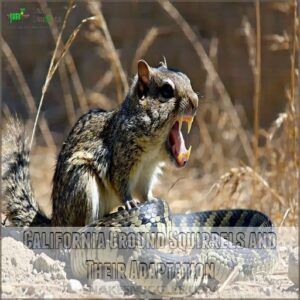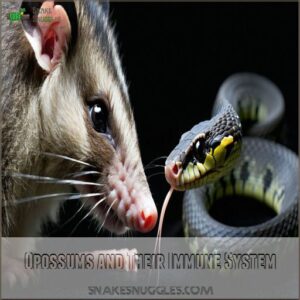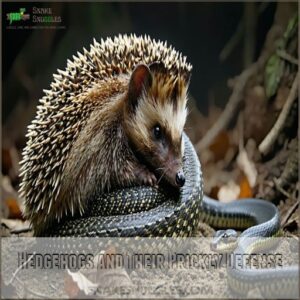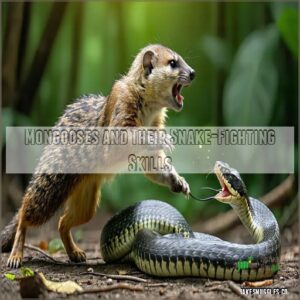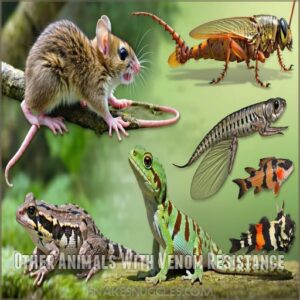This site is supported by our readers. We may earn a commission, at no cost to you, if you purchase through links.
 You’re curious about what animals are immune to snake venom? That’s fascinating!
You’re curious about what animals are immune to snake venom? That’s fascinating!
It turns out, several creatures have evolved incredible defenses. Kingsnakes, for example, can eat venomous snakes thanks to their resistance.
Similarly, woodrats have a specialized immune system that neutralizes rattlesnake venom. Opossums and mongooses also boast impressive resistance mechanisms, showcasing nature’s amazing adaptability.
These animals aren’t completely immune, but they’ve developed ways to handle a bite. Think of it as their own superpower!
Want to know how they do it? We’ll explore the science behind their amazing abilities.
Table Of Contents
- Key Takeaways
- Animals Immune to Snake Venom
- Creatures That Can Withstand Snake Venom
- Animals That Could Be Immune to Rattlesnake Venom
- Physical Defenses Against Venom
- The Science Behind Venom and Poison
- Venom Resistance in Animals and Its Implications
- Frequently Asked Questions (FAQs)
- What animals are immune to snake venom?
- Do snakes have different venom toxicity?
- Are kingsnakes immune to Venom?
- Can animals resist snake venom?
- What causes snake venom immunity?
- Are pigs immune to snake venom?
- What creatures are immune to snake venom?
- What animals are not affected by poisonous snakes?
- What animal has anti snake venom?
- Why are pigs immune to snake bites?
- Conclusion
Key Takeaways
- You’d be surprised that animals like honey badgers, mongooses, woodrats, hedgehogs, and opossums have evolved venom resistance to survive deadly snake bites.
- Kingsnakes and indigo snakes can even hunt and eat venomous snakes due to their genetic adaptations that neutralize venom.
- Some animals, like pigs and California ground squirrels, rely on thick skin or genetic quirks to reduce venom’s effects and protect themselves.
- Venom resistance typically involves mutations, specialized peptides, or cellular adaptations, shaped by evolutionary pressures and predator-prey dynamics.
Animals Immune to Snake Venom
Ever wondered how some animals can dance with danger, laughing in the face of deadly snake venom?
You’ll be amazed to discover the incredible creatures that have developed remarkable immunity, turning what would be a fatal encounter into just another day in the wild.
Woodrats and Their Unique Immunity
Ever wondered how a small rodent could stand up to a deadly rattlesnake? Meet the woodrat, nature’s unlikely venom-resistance champion! These remarkable creatures have developed an extraordinary defense mechanism against snake venom that’ll blow your mind.
- Superhero immune system: Specialized cells neutralize rattlesnake toxins
- Battle-ready attitude: Woodrats fearlessly confront venomous predators
- Habitat-driven evolution: Survival strategy perfected over generations
- Smart survival tactics: Strategic behavioral adaptations minimize snake encounters
Their genetic blueprint allows them to transform from potential prey to formidable opponents. Woodrats’ venom resistance isn’t just a lucky break—it’s a proof of nature’s incredible adaptive powers, showcasing how evolutionary pressures can create seemingly impossible survival strategies.
Kingsnakes and Their Evolutionary Advantage
Right on the culinary edge of survival, kingsnakes have mastered a diet most predators would flee from: venomous snakes.
Their remarkable venom resistance stems from millions of years of evolutionary pressures, allowing them to hunt and consume prey that would kill other animals.
These serpent specialists have developed unique survival strategies that make them nature’s ultimate snake-eating champions.
Indigo Snakes and Their Venom Resistance
Regarding deadly snake bites, indigo snakes are nature’s ultimate survivors. Their venom resistance isn’t just luck—it’s a hardcore evolutionary strategy.
- Diet dominance: Indigo snakes regularly hunt venomous snakes like rattlesnakes and cottonmouths.
- Genetic shield: Specialized immunity mechanisms protect them from neurotoxic venom.
- Survival advantage: This resistance lets them thrive in environments crawling with dangerous predators.
These eastern indigo snake superpowers prove that sometimes, the best defense is a killer offense.
California Ground Squirrels and Their Adaptation
Picture California ground squirrels as nature’s snake-fighting ninjas!
These clever rodents have mastered a remarkable defense against rattlesnakes through incredible squirrel adaptations.
Using infrared signaling and camouflage strategies, they’ve developed partial immunity that gives them an evolutionary edge.
Their genetic snake venom resistance allows them to survive encounters that would spell doom for other prey animals, showcasing the incredible power of adaptation. California ground squirrels are a testament to nature’s power.
Opossums and Their Immune System
After ground squirrels dodge rattlesnakes, opossums take venom resistance to another level.
These marsupial marvels have cracked nature’s most dangerous code: surviving deadly snake bites.
Their unique immune system, packed with specialized opossum venom peptides, neutralizes toxins that would kill most creatures. Scientists are fascinated by their genetic defense mechanisms, which have evolved to block neurotoxins and coagulants.
Opossums: the unexpected champions of venom resistance. Who knew these oddball creatures could outsmart some of nature’s most potent weapons?
Creatures That Can Withstand Snake Venom
Ever wondered how some animals laugh in the face of deadly snake venom while others would succumb in seconds?
You’ll be amazed to discover the incredible survival strategies of creatures like honey badgers, mongooses, and hedgehogs, nature’s ultimate snake venom survivors.
who’ve developed remarkable biological defenses that make them snake venom survivors.
Hedgehogs and Their Prickly Defense
Ever wondered how tiny hedgehogs survive encounters with venomous snakes? These spiky survivors have cracked nature’s defense code with remarkable adaptations. Their prickly armor isn’t just for show – it’s a sophisticated survival strategy that keeps predators at bay. Research on hedgehog snake venom resistance products has shed more light on their ability to withstand certain snake venoms.
- Hedgehog spines: A formidable first line of defense against snake attacks
- Erinacine compound: A natural molecular shield neutralizing certain snake venoms
- Evolutionary marvel: Sophisticated defense mechanisms developed over millennia
- Survival tactics: Curl into a protective posture, exposing sharp spines in all directions
Their unique venom resistance and physical protection make hedgehogs true masters of predator avoidance, proving that sometimes being small doesn’t mean being vulnerable.
Honey Badgers and Their Fearlessness
Regarding honey badgers, fearlessness isn’t just a myth—it’s a survival strategy.
These tenacious creatures boast remarkable venom resistance, thanks to their thick, loose skin and unique molecular defenses.
Whether facing cobras or scorpions, honey badgers laugh in the face of danger, making them nature’s ultimate snake-fighting champions with unparalleled aggression and immunity.
Mongooses and Their Snake-Fighting Skills
Nature’s snake-slaying superheroes aren’t just tough—they’re scientific marvels. Mongooses have turned snake-fighting into an art form, wielding incredible venom resistance through remarkable evolutionary adaptations. These furry warriors boast genetic superpowers that make them the ultimate serpent nemesis.
- Their cellular mutations block neurotoxins with surgical precision
- Specialized enzymes like acetylcholinesterase neutralize venom instantly
- Lightning-fast reflexes and strategic hunting tactics outmaneuver even the deadliest serpents
Egyptian mongooses, in particular, have developed near-miraculous immunity through complex molecular mechanisms. Their thick coat and agile movements transform potential prey into predator, allowing them to target venomous snakes with surgical precision. It’s not just survival—it’s evolutionary mastery in motion.
Other Animals With Venom Resistance
Think animals immune to snake venom are rare? Think again.
Grasshopper mice, fan-fingered geckos, and even certain birds, amphibians, and fish flaunt fascinating venom resistance mechanisms.
These adaptations, shaped by evolutionary pressures, vary widely.
From specialized proteins in their blood to nerve-blocking mutations, these animals resistant to snake venom prove that nature’s arms race creates survivors with mind-blowing prey adaptations and predator strategies.
Animals That Could Be Immune to Rattlesnake Venom
You might be surprised to learn that some animals can shrug off the venom of rattlesnakes like it’s no big deal.
From clever rodents to tough-skinned mammals, these creatures have evolved fascinating ways to survive encounters with these deadly reptiles.
Evolutionary History of Venom Resistance
Venom resistance is like nature’s chess match, shaped by predator-prey dynamics.
Over generations, animals have developed venom resistance mechanisms to outsmart predators, but genetic snake venom immunity comes with a cost.
Some researchers even study animals with natural venom resistance to develop products like those found in venom resistance animals.
The evolution of immunity is relentless; each move in this arms race drives snake venom adaptation and resistance mechanisms, showing how fitness benefits fuel survival strategies in the wild.
Examples of Animals With Venom Immunity
Meet nature’s stealthy fighters—venom-resistant animals with jaw-dropping genetic adaptations.
The woodrat, surprisingly tough against venomous snakes, flips the predator-prey script.
Clever contenders like the grasshopper mouse, fan-fingered gecko, and Texas horned lizard take venom immunity further, thriving amidst threats.
Their tactics, from specific immunity evolution to predator-prey dynamics mastery, underscore the wonders of snake venom immunity.
The Role of Diet in Venom Resistance
What’s on the menu could hold the key to snake venom resistance. Some animals adapt their diet to handle venom exposure, shaping impressive resistance mechanisms.
- Grasshopper mice: These fierce little predators chow down on bark scorpions as if it’s candy. Their venom immunity isn’t just good genetics—it’s partly their choice of prey.
- Fan-fingered geckos: A steady yellow scorpion diet fills their bellies and bolsters natural defenses.
- Texas horned lizards: Their munching on venomous harvester ants showcases how dietary influence impacts animal adaptations. Evolutionary pressure snacks—literally.
The Cost of Venom Resistance
So, you think snake venom resistance is a walk in the park? Think again! It’s a costly superpower.
Animals pay the price with increased energy expenditure and slower growth.
Reproductive tradeoffs are common, and mutation risks are real. Plus, their immune systems might take a hit, impacting lifespan.
It’s a tough bargain, this evolutionary snake venom resistance. But hey, survival’s not free, right?
Physical Defenses Against Venom
Sometimes, the best way to beat venom is to keep it from getting inside you in the first place.
From thick skin to clever body armor, animals have evolved some incredible physical shields against nature’s deadliest toxins.
Leatherback Sea Turtles and Their Thick Skin
Leatherback sea turtles are proof that thick skin isn’t just metaphorical—it’s life-saving! These ocean navigators boast turtle skin thickness that acts like armor, shielding them from jellyfish stings. Plus, their esophagus has protective mechanisms, letting them devour jellyfish without harm.
Some animals, like woodrats, have also developed genetic immunity to snake venom, preventing the binding of peptides present in snake venom.
Check out these evolutionary adaptations:
- Thick skin defense: Their unique structure blocks venomous stings.
- Shell evolution: Lightweight, flexible shells aid speed, dodging ocean predators.
- Plastic threat: Mistaking bags for jellyfish harms digestion.
- Conservation efforts: Projects reduce pollution, ensuring survival.
Their venom resistance mechanisms highlight nature’s brilliant animal defense mechanisms, keeping predators and threats at bay.
Honey Badgers and Their Loose Skin
Honey badgers are like nature’s daredevils, sporting loose, thick skin that’s a game-changer against snake bites. Even if a cobra strikes, their skin stretches, reducing venom’s impact. Pair that with molecular venom resistance, and you’ve got a survival powerhouse.
| Feature | Benefit |
|---|---|
| Loose skin | Harder for venom to penetrate |
| Skin thickness | Provides bite resistance |
| Venom immunity | Neutralizes cobra venom |
| Evolutionary edge | Boosts survival in snake fights |
Skunks and Their Foul-Smelling Liquid
Regarding defense, skunks don’t play around.
Their skunk spray chemistry is a stinky masterpiece, designed to stop predators in their tracks.
While not offering true venom immunity, this evolves as one of nature’s best predator deterrence mechanisms.
- Spray range: Up to 10 feet.
- Accuracy: Surprisingly precise.
- Chemistry: Sulfur compounds.
- Evolved: To protect against predators.
- Snakes? Detoured before biting!
Other Examples of Physical Defenses
From spines to thick skin, animals have some surprising venom resistance mechanisms.
Toads rely on their rugged, bumpy skin for defense.
Feathers on birds? They’re more than just flashy; they protect against venom too.
Snails bring their A-game with armor-like shells, while beetles use tough exteriors.
Check out this quick comparison:
| Animal | Defense Mechanism |
|---|---|
| Toads | Bumpy, rugged skin |
| Birds | Protective feathers |
| Snails | Shell-like armor |
| Beetles | Hard exoskeleton |
| Crabs | Powerful claws |
The Science Behind Venom and Poison
You might think venom and poison are the same, but they’re actually quite different.
While venom needs to be injected to work its magic (or harm),
poison does its dirty job when ingested or absorbed.
The Difference Between Venom and Poison
So, you’re curious about venom and poison? It’s easy to mix them up, but there’s a big difference!
Venom’s injected – think snake bite. Poison is absorbed – like touching poison ivy.
Venom delivery requires a bite or sting, while poison absorption happens through the skin or by eating something poisonous.
Toxicity levels vary wildly, affecting the body differently.
Treatment differences exist too, depending on whether you’re dealing with snake venom or something else.
Ronald’s Rule and The Definition of Venom
You know venom is potent stuff—Ronald’s Rule nails it down: venom must harm via injection and target specific biological systems. It’s like nature’s hypodermic needle, but there are exceptions!
Not all venom packs the same punch, and potency varies.
- Key traits: Injected, system-specific toxins.
- Odd cases: Some milder venoms defy expectations.
- Purpose: Defense, hunting, or territorial clashes.
The Delivery System of Venom
Venom delivery systems are like nature’s specialized syringes. Fang types vary—hollow fangs act like hypodermic needles, while grooved ones guide venom in. Venom glands power these tools, creating a cocktail of venom potency.
Some animals have developed snake venom resistance to counter this efficient system.
| Delivery Method | Example | Depth of Injection | Purpose |
|---|---|---|---|
| Hollow fangs | Rattlesnakes | Deep | Venom injection |
| Grooved fangs | Cobras | Moderate | Quick venom delivery |
| Spines | Stingrays | Surface-level | Defense mechanisms |
| Stingers | Scorpions | Variable | Paralyze prey or defense |
Snake venom composition guarantees predators thrive and prey struggles, showcasing evolution’s efficiency.
The Role of Size in Venom and Poison
In the battle of size versus venom, body mass plays referee.
Larger animals absorb venom differently—they need a bigger venom dose to hit the "lethal dose" mark.
Venom molecules are too bulky to slip through skin; it’s why snakes need fangs.
Smaller prey animals? They’re more vulnerable thanks to their surface area-to-volume ratio.
Snake venom composition exploits this mismatch in size and toxicity masterfully.
Neurotoxic venom composition, such as that found in Black Mamba and Blue Krait venoms, can paralyze even larger animals.
Venom Resistance in Animals and Its Implications
You’d be amazed at how some animals have evolved to shrug off snake venom like it’s no big deal.
These natural defenses also keep them alive but also reveal fascinating insights into biology and survival strategies.
Meerkats and Their Venom Resistance
Regarding animals immune to snake venom, meerkats deserve a spotlight. These playful creatures have a surprising edge—snake venom tolerance. Like their mongoose cousins, they’ve developed exceptional adaptations that help them survive bites from deadly snakes like cobras and puff adders. Their meerkat venom immunity links back to their unique lifestyle: it’s likely influenced by the snakes’ own blood-venom barrier, a defensive mechanism that prevents venom from entering the bloodstream.
- Meerkat diet includes venomous critters like scorpions, likely boosting their resistance.
- They’re sharp learners, living in social groups that collectively spot and manage venomous threats.
- Ever cautious, meerkats emit alarm calls when snakes appear, acting as the group’s lookout.
- Their cooperative behavior and survival skills map onto venom resistance evolution.
While they’re snake survivors, they don’t take chances—something we can all admire.
The Importance of Venom Resistance in Animals
It’s wild how snake venom resistance isn’t just about dodging death—it shapes entire ecosystems.
Animals immune to snake venom hold a survival advantage that rewrites predator-prey dynamics. Genetic mechanisms and evolutionary pressures push these traits forward, balancing nature’s chaos.
These venom resistance mechanisms let some species thrive where others fail, proving that nature’s quirks often hold the key to ecological impact. Venom resistance and ecological impact are intrinsically linked.
Frequently Asked Questions (FAQs)
What animals are immune to snake venom?
Some animals laugh in the face of snake venom.
Honey badgers, mongoose, woodrats, hedgehogs, and pigs all have venom resistance.
They use thick skin, mutations, or special peptides to dodge death and keep predators guessing.
Do snakes have different venom toxicity?
Snake venom toxicity varies widely between species.
Some target nerves, causing paralysis, while others destroy tissue or thin blood.
Factors like diet, environment, and evolutionary pressures shape venom potency, making each species’ venom uniquely effective.
Are kingsnakes immune to Venom?
Think of kingsnakes as nature’s snake-proof superheroes.
They’ve evolved resistance to venom from venomous snakes like rattlesnakes, allowing them to prey on these dangerous reptiles without succumbing to the toxins.
It’s evolution’s clever workaround!
Can animals resist snake venom?
Yes, some animals can resist snake venom through unique adaptations.
From thick skin to venom-neutralizing peptides or cellular mutations, creatures like honey badgers, mongooses, and opossums have evolved impressive defenses against venom’s deadly effects.
What causes snake venom immunity?
Venom immunity happens through mutations in cell receptors that block toxins.
Neutralizing peptides in blood also contribute to venom immunity.
Thick skin preventing venom entry is another mechanism.
Some animals, like mongooses, even evolved specific traits to survive repeated venom exposures. This demonstrates animal adaptation to venomous threats.
Are pigs immune to snake venom?
Pigs aren’t fully immune, but a genetic quirk helps!
A specific mutation prevents some snake venom components from binding to their cells.
Think of it as a tiny shield against certain toxins.
It’s not foolproof, though.
What creatures are immune to snake venom?
You’d be amazed by how many creatures resist snake venom, like honey badgers, mongooses, woodrats, pigs, opossums, grasshopper mice, and hedgehogs.
Each one has evolved unique defenses, from thick skin to venom-neutralizing peptides.
What animals are not affected by poisonous snakes?
Imagine facing a venomous snake and shrugging it off—animals like honey badgers, mongoose, ground squirrels, and opossums do just that.
Their combinations of immunity, thick skin, or venom-neutralizing peptides make them snake-bite survivors.
snake-bite survivors
What animal has anti snake venom?
Honey badgers take the spotlight with their blood-based antivenom, shrugging off multiple snake venom types.
Other animals, like mongooses and opossums, have unique defenses too, thanks to mutations or venom-neutralizing peptides in their systems.
Why are pigs immune to snake bites?
Pigs resist snake bites thanks to their thick skin.
A genetic mutation blocks neurotoxins from binding to receptors.
This double defense makes them tough targets for venom, even against dangerous snake species.
Conclusion
Picture a world where creatures thrive despite nature’s dangers.
That’s exactly what animals immune to snake venom do—they’ve turned deadly bites into minor inconveniences.
From the fearless mongoose to the thick-skinned honey badger, evolution has gifted them astonishing survival tools. These adaptations remind us there’s always more to learn about life’s resilience and hidden superpowers.
Whether it’s a king snake feasting on rattlers or an opossum neutralizing toxins, nature’s ingenuity is jaw-dropping. Who’s your favorite survivor?




